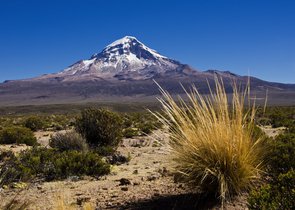Nature Conservation 3/2014 — 24. 8. 2014 — International Nature Conservation — Print article in pdf
Vaněk S.: Altiplano in Bolivia –A Region of Hard Life
- kraj drsného života

In Bolivia, both life-form and habitat diversity includes Amazonian lowlands as well as the high Andes, cloud forests (yungas) as well as the puna, a high elevation montane grassland.
The remoteness of many unique areas has been a perfect tool to conserve them. Nevertheless, the South American country does not rely only for the above natural protection, but it actively manages National Parks, reserves or other protected areas.
The Sajama region was the first protected area in Bolivia declared in 1939: since 1945, it has been a National Park. It is located on the Altiplano and featuring a spectacular Andean landscape, its elevation ranges from 4,200 to 6,542 m a.s.l. Important volcanic cones, like Mount Sajama, the highest peak in the country, and the Payachatas are located in the park, together with several lagoons and high lying Andean marshes, where hardy and silicified grasses and a variety of rosette-shaped plants are to be found. Fauna includes 71 bird and 27 mammal species, i.a. the Darwin´s rhea (Pterocnemia pennata), Andean condor (Vultur gryphus) or the Culpeo (Lycalopex culpaeus), although the Vucugna (Vicugna vicugna) is the best known. On the Laguna Colorada within the Eduardo Avaroa Andean Fauna National Reserve, three flamingo species breed. The globally threatened Andean Mountain Cat (Leopardus jacobita) can be only rarely seen: moreover, the carnivore species has been recently studied, using also telemetry.
As all protected areas in Bolivia are inhabited, nature conservation is not possible against the will of the local people. It is necessary to take their traditional rights, existing value systems and social organisation into account.

